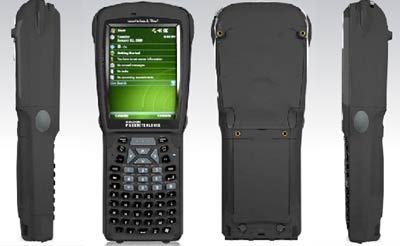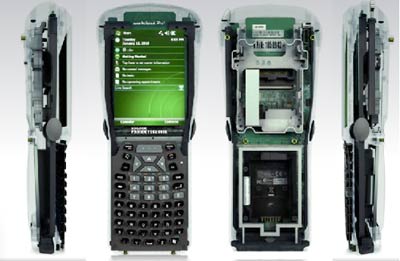|
Psion Teklogix WorkAbout Pro 3
Improved third generation of Psion Teklogix's WorkAbout emphasizes modularity, expansion
(by Conrad H. Blickenstorfer)
On March 4, 2010, Psion Teklogix introduced the WorkAbout Pro 3 rugged handheld terminal. The WorkAbout Pro line has long been a workhorse for Psion Teklogix, and the new and improved model will eventually replace the 2nd Generation version (introduced in 2007).
According to Psion Teklogix, the WorkAbout 3 incorporates ideas that are part of Psion Teklogix' move to "Open Source Mobility" that emphasizes co-creation of solutions with its partners and customers via provision of a more modular product platform that allows sharing of common components and tools with developers, resellers and clients. The goal with the WorkAbout 3 was to make it easy to upgrade or change software with a flexible, "future-proof" design that allows businesses to customize the devices to meet their specific needs. Psion Teklogix, however, stresses that the new Workabout Pro 3 is also backwards compatible with other devices in the Workabout Pro line, software and add-ons, allowing for seamless migration and eliminating the need to reinvest in new equipment.
Below you can see the WorkAbout Pro 3 from all sides, including an "X-ray" version of the views:


What hasn't changed with the new RoHS-compatible model is that it is a modern flashlight-style handheld computer that combines up-to-date technology with a balance of handy size, low weight, flexibility, and ruggedness that is highly configurable and expandable via a large variety of optional expansion modules.
The new model also benefits from a variety of technology upgrades. These are:
- Performance: the new model uses the 624MHz version of the Marvell PXA270 processor as opposed to the slower 520MHz chip in the second gen product. RAM has been doubled to 256KB, and Flash quadrupled to a full gigabyte.
- Ruggedness: the WorkAbout 3 is even more rugged with a wider operating temperature range (-4 to 122F) and an even more impressive drop spec (six feet instead of five).
- Display: The large full-VGA 3.8-inch display is sharper and brighter, yet uses less battery power.
- Usability: there are now four new keyboard layouts including a full QWERTY keyboard and additional keys makes it easier to navigate even with one hand.
- Battery: the capacities of both the standard and the optional extended battery are10% higher.
- Wireless: Wireless performance is faster via modules that include the latest and fastest wireless standards.
On the software side, the device still runs either Microsoft Windows CE 5.0 or Windows Mobile 6 Classic or Professional, and there are numerous programming environments such as the Psion Teklogix Mobile Devices SDK, .NET and C++ via Microsoft Visual Studio 2005, Java supporting JDK 1.2.2 or higher, HTML, XML and numerous standard Windows APIs.
Even more so than earlier generation products, Psion Teklogix offers numerous configurations and expansion modules/options for the WorkAbout 3 either via a 100-pin expansion interface or modules. Available via optional expansion modules are Bluetooth Class II, version 2.0 + EDR, 802.11a/b/g, and GSM/GPRS/EDGEor 3G HSDPA voice/data. For barcode reader applications there are optional 1D and 2D imager as well as standard and high performance laser scanners and a bolt-on pistol grip. There are also various RFID modules available (LF, HF, UHF, and MIFARE).
The WorkAbout Pro 3 comes in two varieties, a C and a S model. The primary difference is that one has an alphanumeric keyboard whereas the other has a numeric keypad or a modified alphanumeric keyboard and is a bit shorter.
Overall, the Psion Teklogix WorkAbout Pro 3 represents a technology, ergonomics, and versatility upgrade of an already very competent line of rugged handhelds. It's geared towards a range of industries, including mobile field services, logistics, warehousing, transportation, manufacturing, etc., and Psion Teklogix's new emphasis on a more modular platform approach greatly increases the application potential of the terminal.
|



